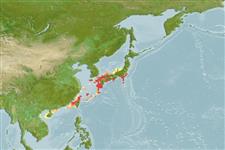Common names from other countries
Teleostei (teleosts) >
Gobiiformes (Gobies) >
Gobiidae (Gobies) > Gobiinae
Etymology: Trimma: Greek, trimma, -atos = something crushed (Ref. 45335); kudoi: Named for Mr. Takahiro Kudo, who provided the holotype of the new species..
Environment: milieu / climate zone / depth range / distribution range
Ecology
Marine; demersal; depth range 27 - 45 m (Ref. 75202). Temperate
Northwest Pacific: Japan.
Size / Weight / Age
Maturity: Lm ? range ? - ? cm
Max length : 2.5 cm SL male/unsexed; (Ref. 75202)
Short description
Identification keys | Morphology | Morphometrics
Dorsal spines (total): 7; Dorsal soft rays (total): 9 - 10; Anal spines: 1; Anal soft rays: 9; Vertebrae: 26. This species differs from its congeners in the following combination of characters; scales on predorsal midline absent; elongate spines of first dorsal fin absent; 5th pelvic-fin ray unbranched, 50-70% of 4th ray in length; basal membrane between innermost pelvic-fin rays 10-17% of length of 5th ray; a shallow or deep interorbital trough, no postorbital trough; nape with a slightly developed longitudinal ridge in the midline; longitudinal scales 22-23; head ground color and body bright yellow, with iris vivid yellow, 3 deep purple oblique lines margined by pink when fresh (Ref. 75202).
Life cycle and mating behavior
Maturities | Reproduction | Spawnings | Egg(s) | Fecundities | Larvae
Suzuki, T. and H. Senou, 2008. Two new species of the gobiid fish genus Trimma (Perciformes: Gobioidei) from Southern Japan. Bull. Natl. Mus. Nat. Sci. Ser. A. Suppl. 2:97-106. (Ref. 75202)
IUCN Red List Status (Ref. 130435)
CITES (Ref. 128078)
Not Evaluated
Threat to humans
Harmless
Human uses
Tools
Special reports
Download XML
Internet sources
Estimates based on models
Preferred temperature (Ref.
115969): 20.6 - 22.7, mean 22.1 (based on 5 cells).
Phylogenetic diversity index (Ref.
82804): PD
50 = 0.5000 [Uniqueness, from 0.5 = low to 2.0 = high].
Bayesian length-weight: a=0.01023 (0.00477 - 0.02194), b=3.02 (2.84 - 3.20), in cm Total Length, based on LWR estimates for this (Sub)family-body shape (Ref.
93245).
Resilience (Ref.
120179): High, minimum population doubling time less than 15 months (Preliminary K or Fecundity.).
Fishing Vulnerability (Ref.
59153): Low vulnerability (10 of 100).
